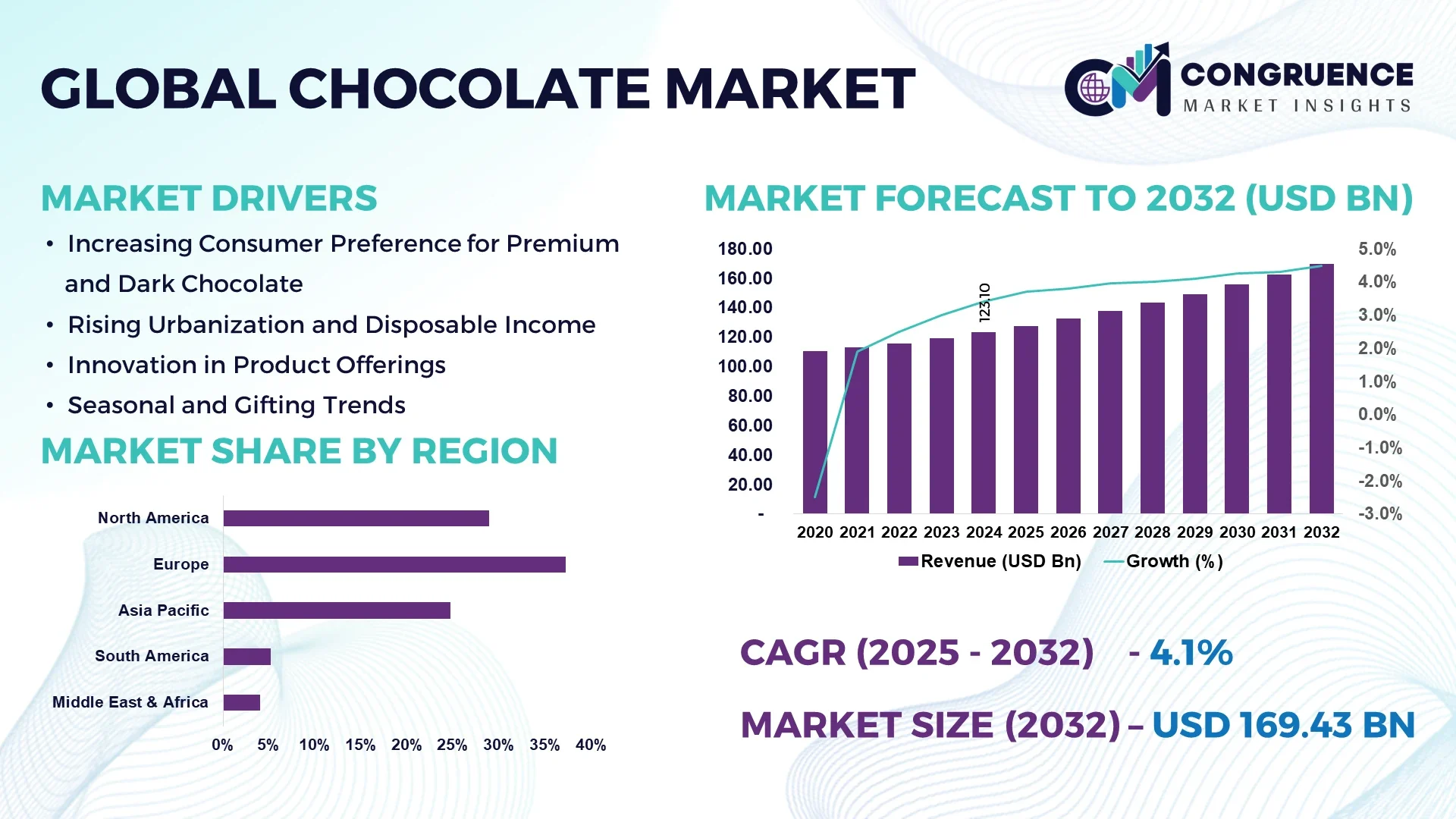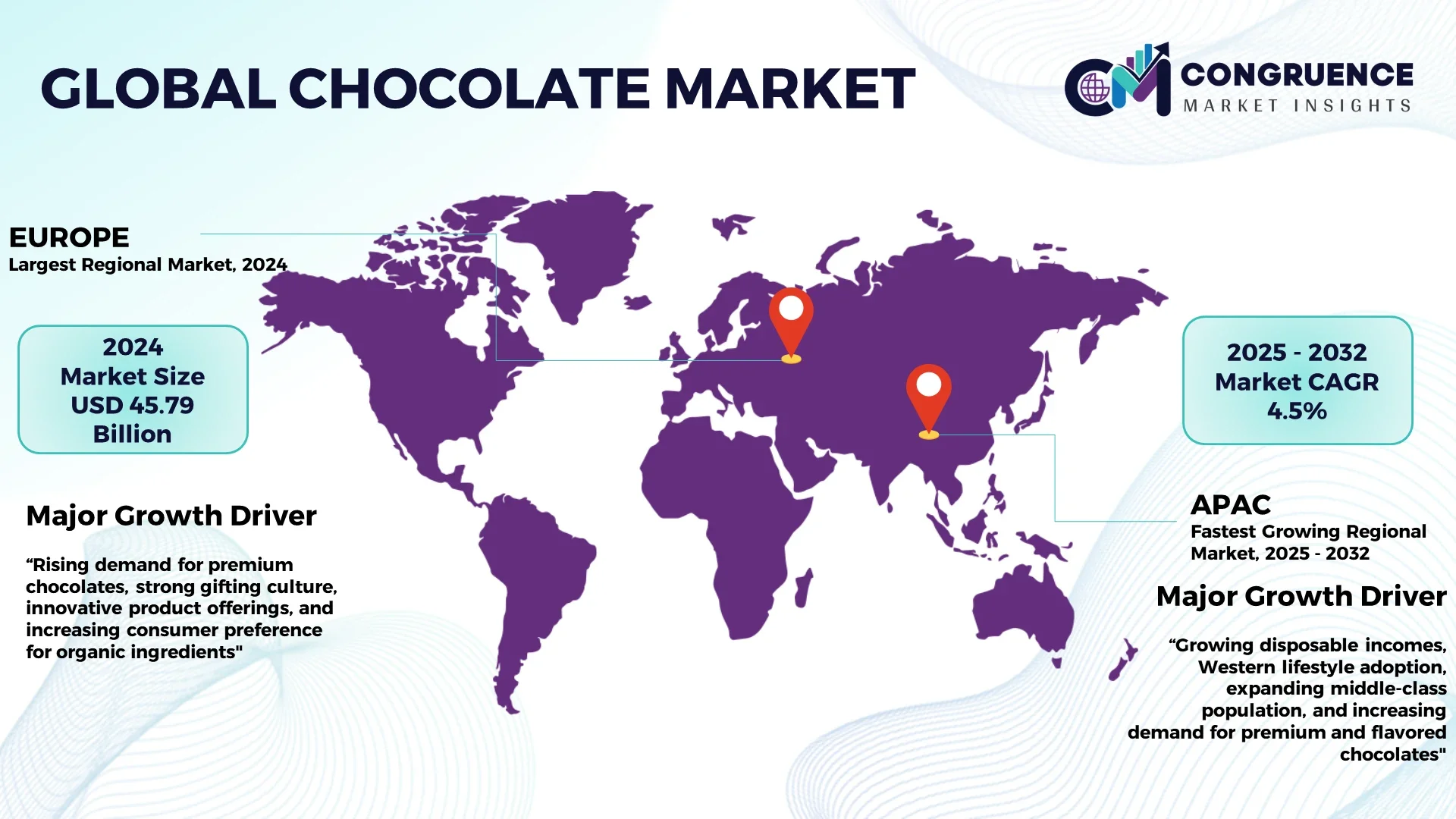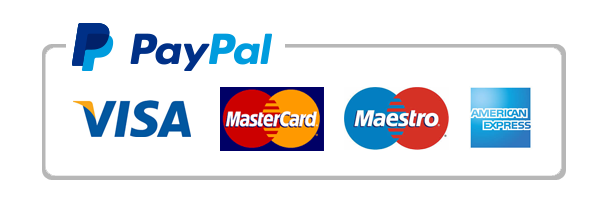Reports
Chocolate Market Size and Forecast 2025 to 2032
The Global Chocolate Market was valued at USD 123.10 Billion in 2024 and is anticipated to reach a value of USD 169.43 Billion by 2032 expanding at a CAGR of 4.1% between 2025 and 2032.

To Learn More About This Report, Request A Free Sample Copy
Chocolate remains one of the world's most popular confections, with demand driven by shifting consumer preferences, health benefits linked with dark chocolate, and rising purchasing power in developing economies. The market includes a variety of product varieties, such as dark, milk, and white chocolate, with applications ranging from confectionery to beverages, cosmetics, and pharmaceuticals. The growing awareness of the health advantages of cocoa flavonoids, particularly in the premium dark chocolate sector, is driving market expansion.
Consumer tastes, creative product introductions, and the emergence of luxury and artisanal chocolates have all contributed to a dramatic transformation of the worldwide chocolate business. Chocolate, which was traditionally primarily associated with confectionery, has now found applications in a variety of industries, including beverages, cosmetics, and pharmaceuticals. The growing desire for premium and dark chocolates, which provide health benefits due to their high antioxidant content, is influencing consumer demand across the board. Furthermore, increased urbanization, rising disposable incomes, and the availability of chocolates through a variety of distribution channels, including supermarkets, hypermarkets, and online platforms, have aided market expansion.
Seasonal consumption remains an important aspect, with holidays such as Christmas, Easter, and Valentine's Day fueling peak sales. On the supply side, raw material procurement, especially cocoa, is highly focused in regions such as West Africa, where environmentally and socially conscious farming practices are gaining traction. The growing trend for sustainably and ethically produced cocoa is projected to have a significant impact on the future dynamics of the global chocolate business.
How AI is Transforming Chocolate Market
Artificial intelligence (AI) is revolutionizing the chocolate industry by increasing operational efficiency, boosting product quality, and enabling more tailored client experiences. AI is being incorporated into industrial processes to maintain consistency in chocolate quality and enhance resource utilization. AI-powered predictive maintenance systems allow firms to track equipment performance in real time, saving downtime and preventing costly failures. This leads to increased production efficiency and lower operating expenses.
AI also has a huge impact on product creation. Companies may quickly develop and release new items that appeal to their target audiences by researching customer preferences and social media trends. For example, AI systems may evaluate consumer behavior data to identify the most popular flavors, textures, and packaging designs, allowing businesses to adapt faster and satisfy changing consumer needs.
Furthermore, AI is employed throughout the supply chain to improve inventory management and demand forecasting. Companies that effectively estimate consumer demand can eliminate waste, overstocking, and assure timely deliveries. This allows producers to better balance output and market demand. Furthermore, AI-powered chatbots and recommendation engines on e-commerce platforms improve the customer shopping experience, offer personalized product recommendations, and boost customer loyalty. As AI evolves, its applications in the chocolate sector are projected to grow, ranging from sustainable cocoa sourcing to new product developments and improved marketing methods.
Chocolate Market Major Driving Forces
· Increasing Consumer Preference for Premium and Dark Chocolate: As consumers become more health-conscious, demand for dark chocolate, which is high in antioxidants and low in sugar, is increasing. The premium chocolate category is expanding rapidly, driven by affluent consumers who prefer high-quality ingredients and artisanal manufacturing methods.
· Rising Urbanization and Disposable Income: Rising urbanization and disposable incomes, particularly in emerging nations such as China and India, are fuelling demand for chocolate products. The expanding middle-class population in these areas is adopting Western purchasing habits, such as indulging in chocolate as a pleasure or gift.
· Innovation in Product Offerings: Chocolate manufacturers are developing novel goods, such as functional chocolates with added health advantages, sugar-free solutions for diabetics, and exotic flavors to cater to a wide range of consumer interests. This innovation is driving up the demand for differentiated items in a competitive market.
· Seasonal and Gifting Trends: Chocolate's popularity as a gift item, particularly during holidays like Christmas, Valentine's Day, and Easter, remains an important driver of sales. Seasonal demand frequently leads to product introductions and limited-edition versions, which pique customer curiosity and generate sales increases during peak seasons.
Chocolate Market Key Opportunities
· Expansion in Emerging markets: The growing middle-class population and urbanization in emerging nations, notably in Asia Pacific and Latin America, offer enormous growth potential. Manufacturers are entering these markets with tailored product offers and localized flavors to cater to new consumer niches.
· Sustainability and Ethical Sourcing: As people become more environmentally concerned, there is a greater demand for responsibly sourced cocoa and eco-friendly packaging. Brands that stress ethical sourcing and fair-trade certifications have a unique chance to engage environmentally conscious customers while distinguishing themselves from competition.
· Personalization and Customization: The trend of personalized and customizable chocolate products, particularly through internet channels, is gaining traction. Consumers are increasingly seeking out unique experiences, and firms who provide personalized packaging, custom tastes, or even the chance to design their own chocolate are well-positioned to capitalize on this developing trend.
· Health and Wellness Focus: As customers prioritize health and wellness, chocolate manufacturers can innovate by including functional ingredients like vitamins, probiotics, and superfoods. Sugar-free, organic, and vegan chocolates are also becoming more popular among this expanding health-conscious audience.
Chocolate Market Key Trends
· As health-conscious consumers seek cleaner labels and ethically sourced products, the demand for organic and vegan chocolates is increasing. Manufacturers are increasingly using plant-based components to appeal to this small but expanding consumer base.
· Premium and craft chocolates are becoming increasingly popular among discerning consumers. These chocolates are frequently regarded as decadent treats and are linked with high quality, flavor, and artistry.
· Chocolate producers are increasingly focused on sustainable sourcing procedures. Companies are committed to traceable and ethically sourced chocolate, as well as tackling deforestation, child labor, and fair farmer remuneration in their supply chains.
· The proliferation of e-commerce platforms has made it easier for customers to buy chocolates online, particularly during the holiday season. Personalized chocolate gifts and subscription boxes are increasingly popular among online consumers.
Region-wise Market Insights
Europe accounted for the largest market share at 37.2% in 2024 whereas, Asia Pacific is expected to register the fastest growth, expanding at a CAGR of 4.5% between 2025 and 2032.

To Learn More About This Report, Request A Free Sample Copy
Europe had the greatest market share of 37.2% in 2024, worth USD 45.79 billion. The region is home to some of the world's most recognized chocolate brands and has a high per capita chocolate consumption rate. Countries like Switzerland, Germany, and Belgium are important marketplaces. Furthermore, European customers are increasingly preferring premium and dark chocolates, which is fueling market expansion.
· In December 2024, Mondelez International is reportedly exploring a potential acquisition of Hershey in a deal valued at around $50 billion. This acquisition would significantly expand Mondelez's portfolio and presence in the chocolate and confectionery markets, potentially reshaping the competitive landscape in the food industry. Discussions are still ongoing, and no official decision has been made.
Asia Pacific is predicted to experience the fastest development, with a CAGR of 4.5% between 2025 and 2032. Chocolate consumption is increasing in countries such as China, India, and Japan, owing to rising disposable incomes, urbanization, and shifting consumer preferences. The region is also experiencing an increase in demand for unique flavors and premium products.
North America dominates the industry, owing to the high demand for premium and dark chocolates. The United States, in particular, is an important market, with customers looking for healthier alternatives like low-sugar and organic chocolates. Latin America, the Middle East, and Africa are expanding markets with significant development potential due to increased urbanization, rising middle-class populations, and a growing demand for luxury chocolate products.
Recent Developments
· In February 2025, Nestlé India announced an investment to expand production capacity for KitKat at its Sanand factory in Gujarat. This expansion aligns with the company’s focus on meeting increasing consumer demand for KitKat and reinforces its commitment to the Indian market. Nestlé aims to boost local production and strengthen its supply chain in the confectionery segment.
· In September 2024, Mondelēz International announced plans to acquire Evirth, a leading player in China's fast-growing healthy snacks market. This acquisition aims to strengthen Mondelēz’s presence in China by expanding its portfolio in the health-conscious snack segment, aligning with global consumer trends. The move is part of Mondelēz's strategic focus on growth in key markets and categories.
· In August 2024, Mars announced plans to acquire Kellanova in a $36 billion deal. This acquisition aims to enhance Mars' portfolio in the food industry, particularly focusing on strengthening its presence in the healthy and sustainable food sector. The deal aligns with Mars' strategic growth initiatives and bolsters its position in the evolving global food market.
· In June 2024, Mondelēz International announced a partnership with Lotus Bakeries to expand the global reach of the popular Lotus Biscoff biscuits. The collaboration aims to leverage Mondelēz's scale and distribution capabilities while maintaining Lotus Bakeries' strong brand identity. This partnership seeks to capitalize on the growing demand for Biscoff-flavored products and enhance the presence of Lotus Biscoff biscuits worldwide.
Market Competition Landscape
The global chocolate market is highly competitive, with key players focusing on innovation, product differentiation, and expanding their global presence. Mondelez International, Mars, and Nestlé dominate the industry with well-known brands and diverse product portfolios that range from gourmet chocolates to mass-market products. To suit changing customer tastes, leading companies are boosting their investments in healthier, organic, and ethically sourced chocolate. Sustainability is a prominent trend, with firms stressing eco-friendly practices including fair-trade sourcing and environmentally responsible packaging. The emergence of smaller, artisanal chocolate manufacturers increases competition, particularly in specialized markets. Regional companies in emerging countries, particularly in Asia Pacific, are expanding rapidly, buoyed by rising consumer demand for premium and luxury chocolate. Companies are also increasing their e-commerce presence and implementing digital marketing methods to reach a younger, more tech-savvy clientele. Mergers, acquisitions, and strategic partnerships continue to be important tactics for industry leaders seeking to maintain a competitive advantage.
Key players in the global chocolate market implement various organic and inorganic strategies to strengthen and improve their market positioning. Prominent players in the market include:
· Mondelez International
· Mars, Incorporated
· Nestlé S.A.
· The Hershey Company
· Lindt & Sprüngli AG
· Meiji Holdings Co., Ltd.
· Barry Callebaut
· Pladis Global
· Chocoladefabriken Lindt & Sprüngli AG
· Godiva Chocolatier, Inc.
· Cémoi Group
· Guylian
|
Report Attribute/Metric |
Details |
|
Market Revenue in 2024 |
USD 123.10 Billion |
|
Market Revenue in 2032 |
USD 169.43 Billion |
|
CAGR (2025 – 2032) |
4.1% |
|
Base Year |
2024 |
|
Forecast Period |
2025 – 2032 |
|
Historical Data |
2020 to 2024 |
|
Forecast Unit |
Value (US$ Bn) |
|
Key Report Deliverable |
Revenue Forecast, Growth Trends, Market Dynamics, Segmental Overview, Regional and Country-wise Analysis, Competition Landscape |
|
Segments Covered |
· By Type (Dark Chocolate, Milk Chocolate, White Chocolate, and Others) · By Frequency (Premium, Seasonal, and Everyday) · By Application (Confectionery, Beverages, Cosmetics, and Pharmaceuticals) · By Distribution Channel (Supermarkets & Hypermarkets, Specialty Stores, Convenience Stores, Online Retailers, and Others) |
|
Geographies Covered |
North America: U.S., Canada and Mexico Europe: Germany, France, U.K., Italy, Spain, and Rest of Europe Asia Pacific: China, India, Japan, South Korea, Southeast Asia, and Rest of Asia Pacific South America: Brazil, Argentina, and Rest of Latin America Middle East & Africa: GCC Countries, South Africa, and Rest of Middle East & Africa |
|
Key Players Analyzed |
Mondelez International, Mars, Incorporated, Nestlé S.A., Ferrero Group, The Hershey Company, Lindt & Sprüngli AG, Meiji Holdings Co., Ltd., Barry Callebaut, Pladis Global, Chocoladefabriken Lindt & Sprüngli AG, Godiva Chocolatier, Inc., Cémoi Group, Guylian |
|
Customization & Pricing |
Available on Request (10% Customization is Free) |
